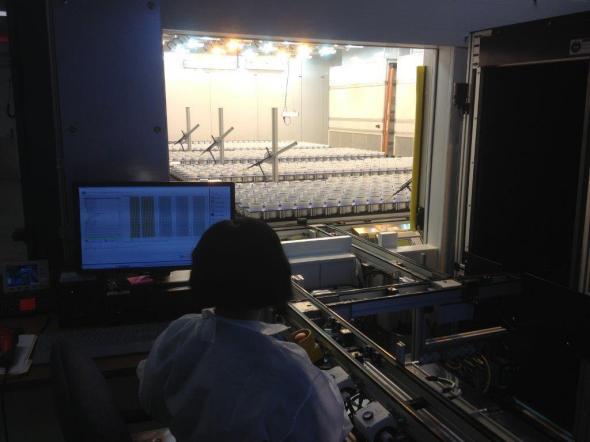People are obsessed with conveyor belts. On the one hand they represent the surge of industry and hometown American values. On the other, automation tends to figure into many a dystopian future. And it’s especially bad anytime food is involved, as with Chipotle’s latest viral spot “The Scarecrow” or its predecessor “Back to the Start.” But aside from all that animated gloom and doom, there are ways in which automation stands to add a lot to the world’s plate.
At least this is the idea behind the Bellwether Foundation Phenotyping Facility that opened in St. Louis last month, the first of its kind. In this $3.5 million, 1,755 square foot addition to the Donald Danforth Plant Science Center, scientists can monitor plant growth, photosynthesis, and water content with Walter White-like precision. By way of conveyor and robotic arm, test plants receive meticulous portions of everything they need—the conveyors truck them through watering and nutrient stations—in addition to near-constant checkups from three kinds of imaging systems. (You can take a tour of the plant in the video below.)
So, why would we want to raise plants with the kind of oversight typically reserved for Chinese gymnasts? Well, first of all, I assume you like that “eating” thing we do. By understanding a plant’s growth properties, we can tweak them to capture energy, conserve water, or use fertilizer more efficiently. In turn, this may lead to crops capable of growing in new areas, surviving drought, or producing food with less impact to the environment—all adaptations becoming more necessary by the day thanks to climate change.
“There are enormous amounts of information we can gather by repeating the imaging every day, or even twice a day,” said Dr. James Carrington, president of the Danforth Plant Science Center.
It also lets you monitor plants without destroying them. The facility tracks plant growth in three ways. It takes color photos from multiple angles that can be reconstructed into three-dimensional images, which in turn can be played in succession to create a stop-motion movie of growth. Near-infrared imaging analyzes water content. And fluorescent imaging allows scientists to measure how well a plant is performing photosynthesis, down to individual sections of specific leaves. Put it all together and you can monitor 1,200 plants simultaneously.
The first round of experiments at the Bellwether Foundation Phenotyping Facility aims to study grasses used for bioenergy in an attempt to make them more efficient in water usage and drought resistance. Whether that improvement comes through selective breeding or genetic modification depends on the study being done. Carrington said the facility is open to partnerships with other companies or scientists who could, in essence, rent out the automation room for whatever their little hearts desire.
“Our reason for being is to do good things in the world using plant science,” said Carrington.
That means improving crops, saving the environment, and performing better experiments—one conveyor belt rotation at a time.
